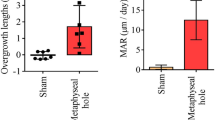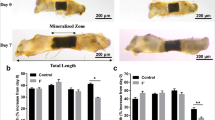Abstract
Both stimulative and inhibitory growth disturbances may occur after a fracture during the growth period. The exact mechanism responsible for stimulative growth disturbances in the immature skeleton is unexplained. It's possible that chondrocyte proliferation leads to overgrowth. This study investigates the effect of a fracture on the proliferation of chondrocytes at the nearby growth plate and its effect on the contra-lateral leg. Fifty-six 1-month-old Sprague–Dawley rats (weight, 100–120 g) were randomised to either an experimental or a control group. A closed mid-diaphyseal tibial fracture was produced in all animals of the experimental group using a standardised technique. On day 3, 10, 14 and 29 of the experiment, the rats were euthanised and their tibial growth plates were subjected to histological analysis. 5′-Bromo-2′-deoxy-uridine labelling was used for the quantitative analysis of chondrocyte proliferation. Safranin O staining provided the histological overview for the subsequent analysis of BrdU-labelling. Immunohistochemical analysis showed increased proliferation of chondrocytes in the growth plates of broken bones during fracture healing. This proliferation peaked on day 3 post-fracture and then reduced gradually until day 29. No increase in the rate of proliferation was observed on the contra-lateral limbs of the animals in the experimental group. Following a diaphyseal fracture of the tibia, the growth plates located next to the fracture react with increased cell proliferation. This proliferation was not observed in the contra-lateral uninjured tibia. This investigation shows that the post-traumatic length discrepancy is a local biological process at the growth plate brought about by the fracture.





Similar content being viewed by others
References
Breitfuss H, Muhr G (1988) Can accelerated longitudinal growth be prevented following pediatric femur shaft fractures? Unfallchirurg 91:189–194
Clement DA, Colton CL (1986) Overgrowth of the femur after fracture in childhood. An increased effect in boys. J Bone Jt Surg Br 68:534–536
Reynolds DA (1981) Growth changes in fractured long-bones: a study of 126 children. J Bone Jt Surg Br 63-B:83–88
Stephens MM, Hsu LC, Leong JC (1989) Leg length discrepancy after femoral shaft fractures in children. Review after skeletal maturity. J Bone Jt Surg Br 71:615–618
Sulaiman AR, Joehaimy J, Iskandar MA et al (2006) Femoral overgrowth following plate fixation of the fractured femur in children. Singapore Med J 47:684–687
Wallace ME, Hoffman EB (1992) Remodelling of angular deformity after femoral shaft fractures in children. J Bone Joint Surg Br 74:765–769
Zimmermann R, Stoger A, Golser K et al (1999) Tibial growth after isolated femoral shaft fracture in the growth stage. Unfallchirurg 102:365–370
Laer L, Herzog B (1978) Leg length differences and rotation defects after femoral shaft fractures in childhood. Therapeutic influence and spontaneous correction. Helv Chir Acta 45:17–21
Aitken AP (1940) Overgrowth of the femoral shaft following fracture in children. Am J Surg 49:147–148
Ogden JA (2000) Skeletal injury in the child. Springer-Verlag, New York
Pring M, Newton P, Rang M (2005) Femoral shaft. In: Rang M, Pring ME, Wenger DR (eds) Rang's children's fractures. Lippincott Williams & Wilkins, Philadelphia, PA, pp 181–200
Rang M, Wenger DR (2005) Children are not just small adults. In: Rang M, Pring ME, Wenger DR (eds) Rang's children's fractures. Lippincott Williams & Wilkins, Philadelphia, PA, pp 1–10
Routt M Jr (1994) Fractures of the femoral shaft. In: Green N, Switontkowski M (eds) Skeletal trauma in children. WB Saunders Company, Philadelphia, pp 345–368
Salter R (1983) Textbook of disorders and injuries of the musculoskeletal system. Williams & Wilkins, Baltimore, MD
Wirth T, Syed Ali MM, Rauer C et al (2001) The influence of local vascular regeneration on growth plate activity after defined growth plate lesions. Eur J Trauma 27:58–65
Zionts LE, Harcke HT, Brooks KM et al (1987) Posttraumatic tibia valga: a case demonstrating asymmetric activity at the proximal growth plate on technetium bone scan. J Pediatr Orthop 7:458–462
Etchebehere EC, Caron M, Pereira JA et al (2001) Activation of the growth plates on three-phase bone scintigraphy: the explanation for the overgrowth of fractured femurs. Eur J Nucl Med 28:72–80
Lee SH, Szoke G, Simpson H (2001) Response of the physis to leg lengthening. J Pediatr Orthop B 10:339–343
Garces GL, Garcia-Castellano JM, Nogales J (1997) Longitudinal overgrowth of bone after osteotomy in young rats: influence of bone stability. Calcif Tissue Int 60:391–393
Gerstenfeld LC, Cullinane DM, Barnes GL et al (2003) Fracture healing as a post-natal developmental process: molecular, spatial, and temporal aspects of its regulation. J Cell Biochem 88:873–884
Kaya AE (1986) Growth plate stimulation by diaphyseal fracture. Autoradiography of DNA synthesis in rats. Acta Orthop Scand 57:135–137
Standring S, Ellis H, Healy JC et al (2005) Gray's anatomy: the anatomical basis of clinical practice. Elsevier Churchill Livingstone, Edinburgh
Ballock RT, O'Keefe RJ (2003) The biology of the growth plate. J Bone Jt Surg Am 85-A:715–726
Forriol F, Shapiro F (2005) Bone development: interaction of molecular components and biophysical forces. Clin Orthop Relat Res 432:14–33
Rauch F (2005) Bone growth in length and width: the Yin and Yang of bone stability. J Musculoskelet Neuronal Interact 5:194–201
Meyer U, Wiesmann HP (2006) Bone and cartilage engineering. Springer-Verlag, Berlin
Abad V, Meyers JL, Weise M et al (2002) The role of the resting zone in growth plate chondrogenesis. Endocrinology 143:1851–1857
Bonnarens F, Einhorn TA (1984) Production of a standard closed fracture in laboratory animal bone. J Orthop Res 2:97–101
Landry PS, Marino AA, Sadasivan KK et al (1996) Bone injury response. An animal model for testing theories of regulation. Clin Orthop Relat Res 332:260–273
Morini S, Continenza MA, Ricciardi G et al (2004) Development of the microcirculation of the secondary ossification center in rat humeral head. Anat Rec A Discov Mol Cell Evol Biol 278:419–427
Murakami S, Noda M (2000) Expression of Indian hedgehog during fracture healing in adult rat femora. Calcif Tissue Int 66:272–276
Ashraf N, Meyer MH, Frick S et al (2007) Evidence for overgrowth after midfemoral fracture via increased RNA for mitosis. Clin Orthop Relat Res 454:214–222
Okafuji N, Liu ZJ, King GJ (2006) Assessment of cell proliferation during mandibular distraction osteogenesis in the maturing rat. Am J Orthod Dentofacial Orthop 130:612–621
Sato C, Muramoto T, Soma K (2006) Functional lateral deviation of the mandible and its positional recovery on the rat condylar cartilage during the growth period. Angle Orthod 76:591–597
Sekine J, Sano K, Inokuchi T (1995) Effect of aging on the rat condylar fracture model evaluated by bromodeoxyuridine immunohistochemistry. J Oral Maxillofac Surg 53:1317–1321
Taylor JH, Woods PS, Hughes WL (1957) The organization and duplication of chromosomes as revealed by autoradiographic studies using tritium-labeled thymidinee. Proc Natl Acad Sci USA 43:122–128
Xiang Z, Markel MD (1995) Bromodeoxyuridine immunohistochemistry of epon-embedded undecalcified bone in a canine fracture healing model. J Histochem Cytochem 43:629–635
Haxhija EQ, Yang H, Spencer AU et al (2006) Influence of the site of small bowel resection on intestinal epithelial cell apoptosis. Pediatr Surg Int 22:37–42
Cho TJ, Gerstenfeld LC, Einhorn TA (2002) Differential temporal expression of members of the transforming growth factor beta superfamily during murine fracture healing. J Bone Miner Res 17:513–520
Einhorn TA (2005) The science of fracture healing. J Orthop Trauma 19:S4–S6
Gerstenfeld LC, Einhorn TA (2003) Developmental aspects of fracture healing and the use of pharmacological agents to alter healing. J Musculoskelet Neuronal Interact 3:297–303
Acknowledgments
This study was supported by a grant from the AO Research Foundation, Switzerland. Furthermore, we want to thank Andrea Groselj-Strele M.Sc., Office for Biostatistics, Center for Medical Research, Medical University of Graz, for her support concerning the statistical processing.
Conflict of interest statement
The authors declare that they have no conflict of interest.
Author information
Authors and Affiliations
Corresponding author
Rights and permissions
About this article
Cite this article
Janezic, G., Widni, EE., Haxhija, E.Q. et al. Proliferation analysis of the growth plate after diaphyseal midshaft fracture by 5′-bromo-2′-deoxy-uridine. Virchows Arch 457, 77–85 (2010). https://doi.org/10.1007/s00428-010-0932-6
Received:
Revised:
Accepted:
Published:
Issue Date:
DOI: https://doi.org/10.1007/s00428-010-0932-6




